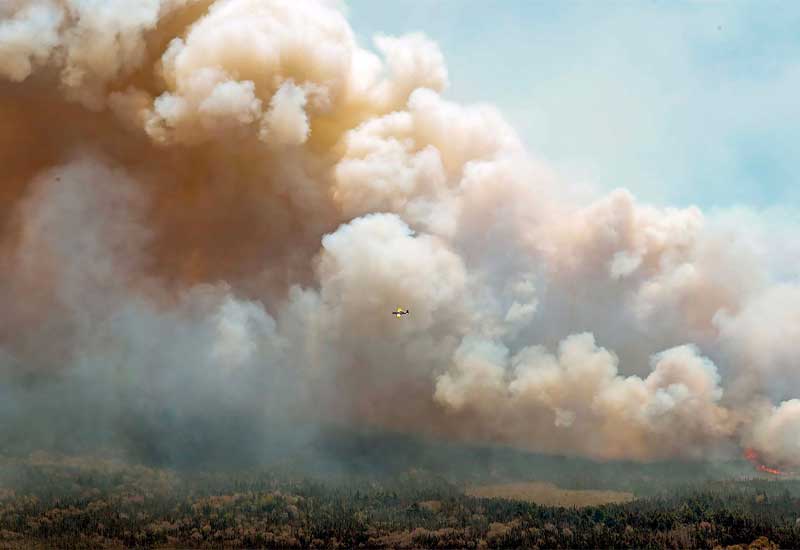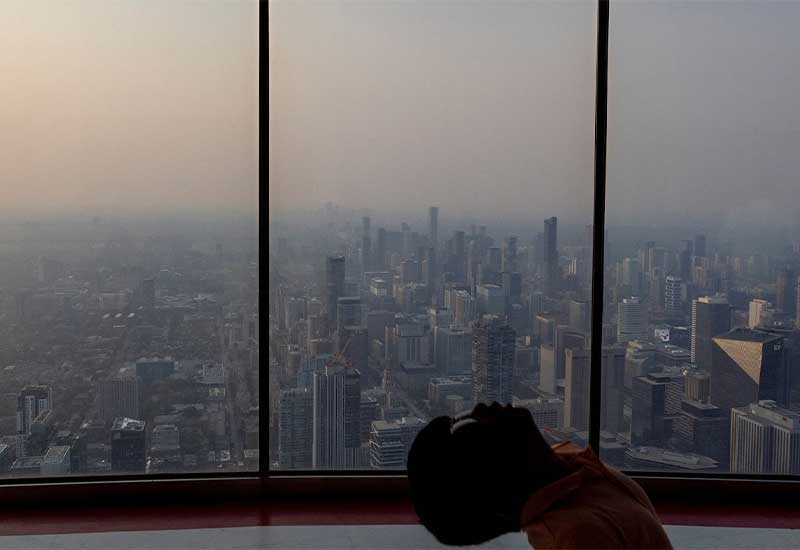The Impact of Canada’s Wildfires: How To Protect Your Indoor Air Quality
 (Nova Scotia government-AFP-Getty Images)
(Nova Scotia government-AFP-Getty Images)
Unprecedented is the word that Canadian officials are using to describe Canada’s wildfires 2023 season. Nine of the country’s thirteen provinces and territories have been burning for the last few weeks, devouring millions of acres of forest.
Besides the fact that wildfires have destroyed hundreds of structures, and forced more than 100,000 people from their homes, wildfire smoke has blown across eastern America. That is why New York City was blanketed by smoke in orange, reminding some of the 1966 “killer smog”.
According to Nature, the culprit behind this is “a large low-pressure system that has been sitting over Maine for several days, dragging the smoke south to the eastern seaboard”, says Jain, a research scientist at the Canadian Forest Service.
A thick veil of wildfire smoke has been pushed to the East Coast and the District, affecting an area from Wisconsin to West Virginia.
 Source: NOAA and NASA
Source: NOAA and NASA
What Is Wildfire Smoke?
Wildfire smoke is a mixture of gases and fine particles that can be harmful to human health. The smoke can contain a variety of pollutants, including particulate matter (PM), ozone (O3), and carbon monoxide (CO).
These pollutants can irritate the eyes, nose, and throat, and can worsen respiratory problems such as asthma, bronchitis, and pneumonia. Wildfire smoke can also cause heart disease, cancer, and premature death.
What Are The Dangers of Wildfire Smoke?
Wildfire smoke poses high health risks to people with respiratory problems, such as asthma and COPD. These people are more likely to experience symptoms such as coughing, wheezing, and shortness of breath when they are exposed to wildfire smoke. Wildfire smoke can also trigger asthma attacks and make it more difficult for people with COPD to breathe.
Respiratory Issues
Inhaling wildfire smoke can irritate the respiratory system and trigger or worsen respiratory conditions such as asthma, bronchitis, and chronic obstructive pulmonary disease (COPD). Fine particulate matter (PM2.5) present in smoke can penetrate deep into the lungs, causing inflammation and difficulty in breathing.
Cardiovascular Problems
The smoke can irritate the lining of the airways and make it harder for the heart to pump blood. This can lead to chest pain, shortness of breath, and other heart problems. Exposure to these pollutants can increase the risk of heart attacks, stroke, and other cardiovascular issues, especially in individuals with pre-existing heart conditions.
Children and the elderly are especially vulnerable to the effects of wildfire smoke. Their respiratory systems are not fully developed, and they may have underlying health conditions that make them more susceptible to the harmful effects of smoke.
How Can Wildfire Smoke Enter Your Home?
 (Angela Weiss-AFP-Getty Images)
(Angela Weiss-AFP-Getty Images)
Wildfire smoke can enter your home through open windows, doors, and vents. It can also enter your home through cracks and gaps around windows and doors. If you live in an area where wildfires are a problem, it is important to take steps to protect your indoor air quality.
Ways to Protect Indoor Air Quality from Wildfire Smoke in Your Home
Here are some tips on how to protect your indoor air quality from wildfire smoke:
Close your windows and doors to keep wildfire smoke out
If you live in an area where wildfires are a problem, close your windows and doors to keep smoke out. You can also use weatherstripping or caulk to seal any cracks or gaps around your windows and doors.
Turn on your HVAC system and use a HEPA air filter
If you have central air conditioning or heating, turn it on and use a HEPA air filter. HEPA filters can remove up to 99.97% of airborne particles, including smoke particles.
Avoid using candles, incense, and other products that produce smoke
Candles, incense, and other products that produce smoke can add to the problem of indoor air pollution. If you must use these products, use them in moderation and ventilate your home well.
Vacuum and dust regularly to remove smoke particles from your home
Smoke particles can settle on surfaces in your home, such as furniture, carpets, and curtains. Vacuum and dust regularly to remove these particles from your home.
Extended Article: Benefits of Using MERV 13 Air Filters In Residential HVAC Systems
How Does Wildfire Smoke Affect Commercial And Industrial Applications?
 (Image by Carlos Osorio Reuters)
(Image by Carlos Osorio Reuters)
Wildfire smoke can have a significant impact on both commercial and industrial applications. The presence of smoke particles in the air can pose various challenges and risks, affecting both the indoor environment and the overall operations.
Indoor Air Quality
Wildfire smoke contains a range of harmful pollutants, including fine particles, volatile organic compounds (VOCs), and hazardous gases. When these particles enter commercial buildings or industrial facilities, they can degrade indoor air quality, leading to health issues for occupants and workers.
Health and Safety Concerns
Exposure to wildfire smoke can cause respiratory problems, eye irritation, and other health issues. This can affect the well-being of employees, customers, and visitors in commercial buildings, as well as the workforce in industrial applications. It is crucial to address these health concerns and ensure a safe working environment.
Equipment and Machinery
Wildfire smoke particles can infiltrate sensitive equipment and machinery in industrial settings. This can lead to clogging, corrosion, and reduced efficiency of the equipment, potentially resulting in operational disruptions, increased maintenance costs, and downtime.
Productivity and Efficiency
Poor indoor air quality due to wildfire smoke can affect the productivity and efficiency of employees in commercial buildings. It can cause discomfort, difficulty in concentration, and decreased overall performance. In industrial applications, compromised air quality can impact the precision and accuracy of manufacturing processes.
Ways to Protect Indoor Air Quality from Wildfire Smoke in Commercial And Industrial Settings
To mitigate the impact of wildfire smoke on commercial buildings and industrial applications, several solutions can be implemented.
Install High-Quality Air Filtration Systems
Use advanced air filtration systems designed to capture fine particles and pollutants. High-efficiency air filters, such as HEPA (High-Efficiency Particulate Air) filters, can effectively remove smoke particles and improve indoor air quality.
Maintain Ventilation Systems And Replace Air Filters Regularly
Ensure proper maintenance of ventilation systems, including regular cleaning, filter replacement, and inspection. Over time, pollutant particles accumulate in the filter, reducing system effectiveness.
By changing the air filter regularly, you ensure that clean and filtered air is circulated throughout your space, improving indoor air quality and reducing the potential for respiratory issues and allergies.
Create Positive Pressure Environments
In commercial buildings and industrial applications, establish positive pressure environments by ensuring the inflow of clean air and minimizing air infiltration from the outside. This approach helps prevent smoke from entering indoor spaces and maintains cleaner air quality.
Enhance Building Envelope
Improve the integrity of the building envelope by sealing gaps, cracks, and other openings. This helps prevent smoke infiltration and maintains a more controlled indoor environment.
Conclusion
Hot, dry, and windy weather conditions are contributing to large wildfires in North America and many other countries around the globe. Study shows Canada’s fire season starts a week earlier and ends a week later than it did in the 1970s.
Protecting indoor air quality during wildfire events is of utmost importance for the health and well-being of individuals. By implementing the tips and measures discussed, you can minimize exposure to harmful wildfire smoke and create a clean indoor environment.
One of the most effective ways to maintain good indoor air quality is by using high-performance air filters. Not only trap and remove pollutant particles from the air but protect air filtration systems from damage.
Clean-Link’s air filters are ranging from different filtration rates, including European and American standards. From pre-filters to HEPA filters, filter media to HVAC filters, Clean-Link offers customized filters for your special needs. Talk to one of our experts to get custom filters.





